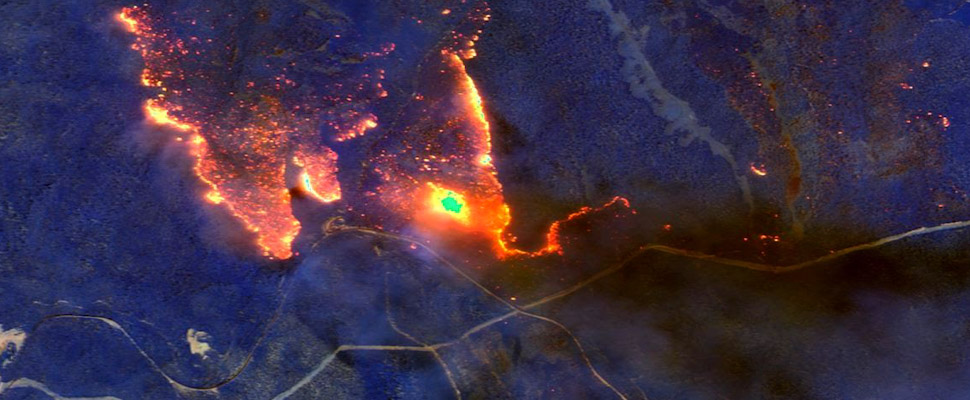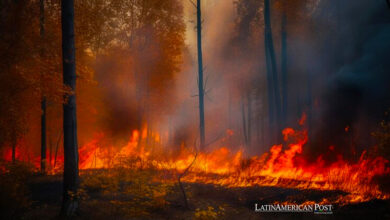Fires in Australia and floods in Indonesia: this is how 2020 began
2020 began with an urgent call from nature about the damage we are doing to it through heavy floods and fires.

Fires in Australia seen from satellite. / Photo: EFE
LatinAmerican Post | Juliana Suárez
Listen to this article
Leer en español: Incendios en Australia e inundaciones en Indonesia: así inició el 2020
The fires in Australia and the floods in Indonesia are only a sign that human actions are depleting the environment, and this is crying out for a change in the unsustainable way of life that we have today.
Since mid-2019, the United Nations warned of unprecedented floods, heat and fires, and it was also said that these disasters would continue to occur in the coming months. As it was well said, 2020 began with two natural disasters that have the world upside down.
Years ago, the Global Risk Forum had warned that the magnitude of natural disasters were on the rise and that in a few years we would see a virtually unstoppable result.
Australia fires
On one side of the world, in Australia, serious fires began to be reported that were spreading over large areas affecting flora, fauna, and even some citizens. The devastating images say it all: kangaroos running for their lives and millions more of this and other species that failed to save themselves.
The reason for these strong fires that have stood out above the others, although Australia in the summer is always a fire-prone area, is due to record temperatures and droughts of months. According to BBC, Australia managed to reach its highest temperatures in history last December: the 17, 40.9º C and the next day, 41.9º C.
Experts agree that this is just the beginning of a wave of fires that will last a few more months, considering that the summer in Australia is just beginning and extending until about March. For this reason, hundreds of people have had to be evacuated as fires are spreading to populated areas near the cities of Sydney and Adelaide.
The number of dead people has risen to 24 in recent months, in addition to dozens of missing persons, since fires have been recorded since September, although it was until the first days of January that it was intensified to such an extent that it shocked the entire world.
Read also: Madagascar's rainforest habitat is also in danger
But the most worrisome is the death of millions of animals and, especially, the total destruction of the habitat of those left alive. According to Professor Chris Dickman, an Australian biodiversity expert at the University of Sydney, 480 million animals, including koalas, kangaroos, other mammals, repeaters and birds, have been directly affected, whether they have died or had to flee of its natural habitat.
This figure was calculated taking into account the possible number of animals per hectare in the area where fires have developed, New South Wales, and multiplying them by the number of hectares that have already been burned (approximately 4 million hectares). This figure, which calculated the last 10 days, is already estimated to have increased much more, since the fires have already left the original zone and have expanded to other states such as Victoria.
In proportion, to understand the magnitude of the crisis that Australia is currently experiencing, BBC recalled that the fires of 2019 in California, United States, damaged 800,000 thousand hectares, and those of the Amazon 900,000 thousand. Meanwhile, at just the beginning of the crisis, Australia has already been more than 4 times that.
Floods in Indonesia
The very warming of the land causes the soil to become prone to flooding. Indonesia began 2020, literally since December 31, with heavy flooding in its capital, where hundreds of thousands have been displaced, taking refuge in shelters where drinking water and food are scarce. Although this Southeast Asian country has always been immersed in seasons of heavy rains at this time of year, the rains with which it received the new year have been unprecedented.
Floods have been caused by heavy rains that have not ceased throughout the region, which has led to river overflow and has affected thousands of homes. So far, at least 170,000 people have been reported and on Monday morning, the death toll reached 66.
In addition to the uncontrollable rains, water currents have led to landslides that prevent people from taking refuge in completely safe places, as well as preventing the arrival of food and supplies to these shelters.
With what it takes from these floods, the largest flood that Indonesia had lived in has already been exceeded in magnitude, in 2013 where at least 20 people died. And this time, in addition to the tripling of the death toll, it is expected that the rains will continue for more days, and that there will also be a thunderstorm.
The Red Cross has reported that they are in charge, in addition to providing necessary help and rescue to those affected, to spray disinfectant in the capital to prevent the spread of disease.




